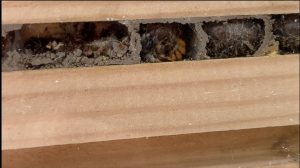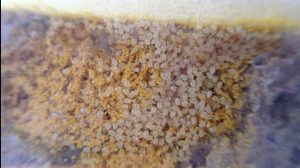The mud cells inside a Red mason bee nest are very hard.
Many people know that Red mason bee females seal their cells with mud to protect their offspring from potential harm and to keep the internal cell environment conducive to the success of its contents. The mud dries very hard so how do the bees leaving the cell actually get out? This is something I have wanted to film as I have never actually seen it, as I suspect many people have n’t either. I am aware of what they do but to actually see it was my mission. I have never managed to get the timing just right for filming. This year I set aside time and was determined to film this process.

Red mason bee starting his quest for freedom! Nurturing Nature
I learnt quite a few things about this journey to freedom. It takes a lot longer than I thought as it can take a long time to chew out of the cocoon, manoeuvre its body to get into position, then chew through the mud wall. It is temperature dependent as well. Imagine the first one who has to also chew through the thicker end plug. I found though one aspect, in particular, stands out, see if you can spot it in the film.
So you can imagine if there is a dead bee in front of the one behind, how difficult it would be for the living specimen to get out. It would have to chew its way through its dead brother which could take a very long time. With a queue of others waiting behind him nipping his rear to get the job done!

Pollen mites waiting to hitch a ride
And if any cell in front is infested with pollen mites there will be a lot of them waiting patiently for their own lift to freedom to start their own little colony inside another Red mason bee’s nest!
Solitary Bees by Ted Benton I highly recommend
Steven Falk’s Field Guide to the Bees of Great Britain and Ireland is a must-have book if you want to ID bees and this extremely useful resource Steven Falk’s Flickr web site which furnishes extra photos and other useful resources to assist with identification.
For more info about wild bees see BWARS

Absolutely fascinating! Thanks for filming and sharing.
Thanks for showing your appreciation. Cheers George
Hi I have bug houses and the bees go in and plug the holes ,but the new born babies don’t come out ,I leave them for ages to hatch out but they don’t , I clean the bug house out later in the year ,
It sounds like your babies may have died or been eaten by pests Caroline. It’s why I give a comprehensive guide to my customers. Ask your supplier to provide you with theirs. George
tHIS IS AMAZING FOOTAGE. i HAVE 2 BEE HOTELs WHICH CAN BE UNSCREWED TO EXPOSE THE LAYERS BUT NOT SURE IF WISE TO DO THIS NOW 18TH MARCH.. I hate the thought of some being trapped inside
I see that some people have extracted the pupae while in the dormant phase but cant find where you are supposed to put them so they can emerge . ideas please.. THANKS, Liz.
I have emailed you, Liz. There’s a ton of info out there if you search google. Cheers, George